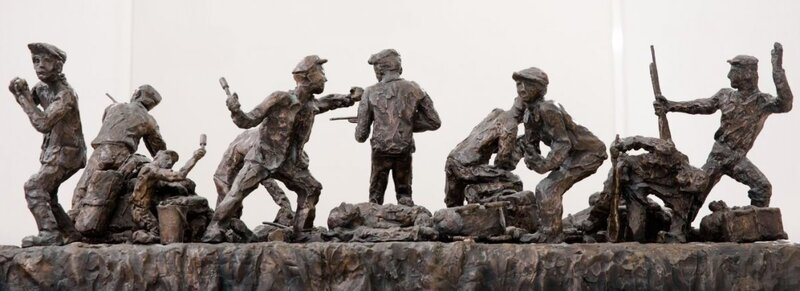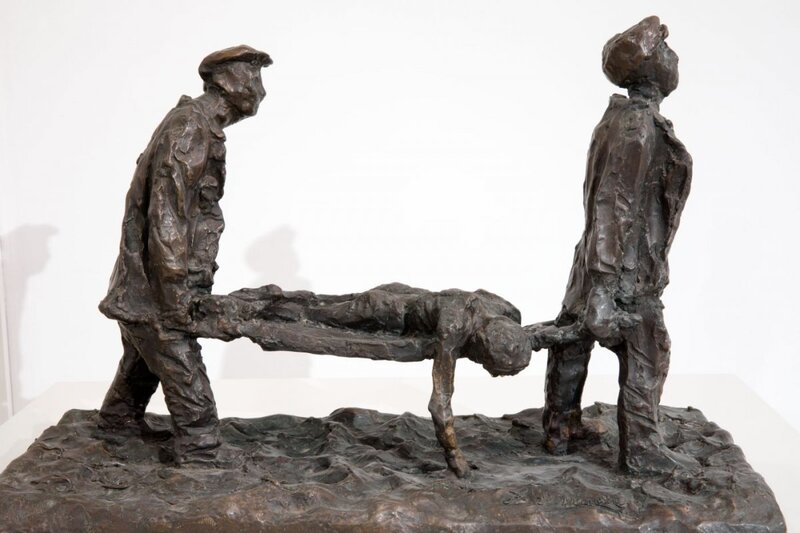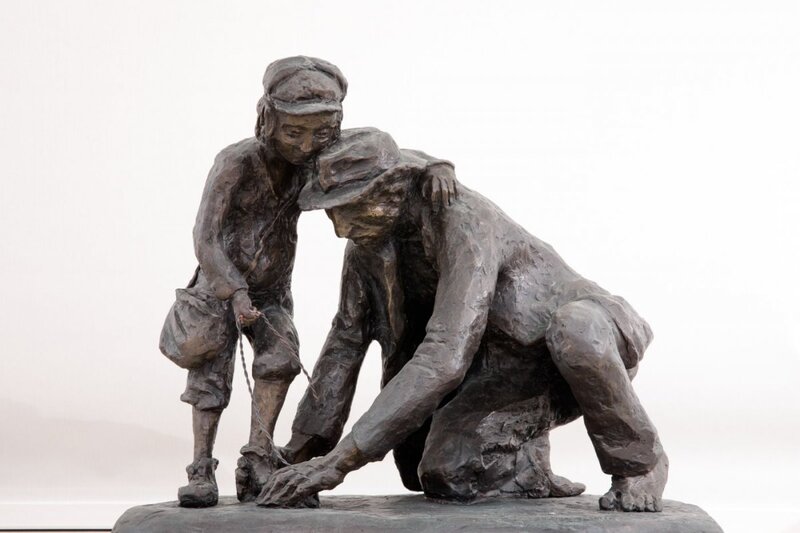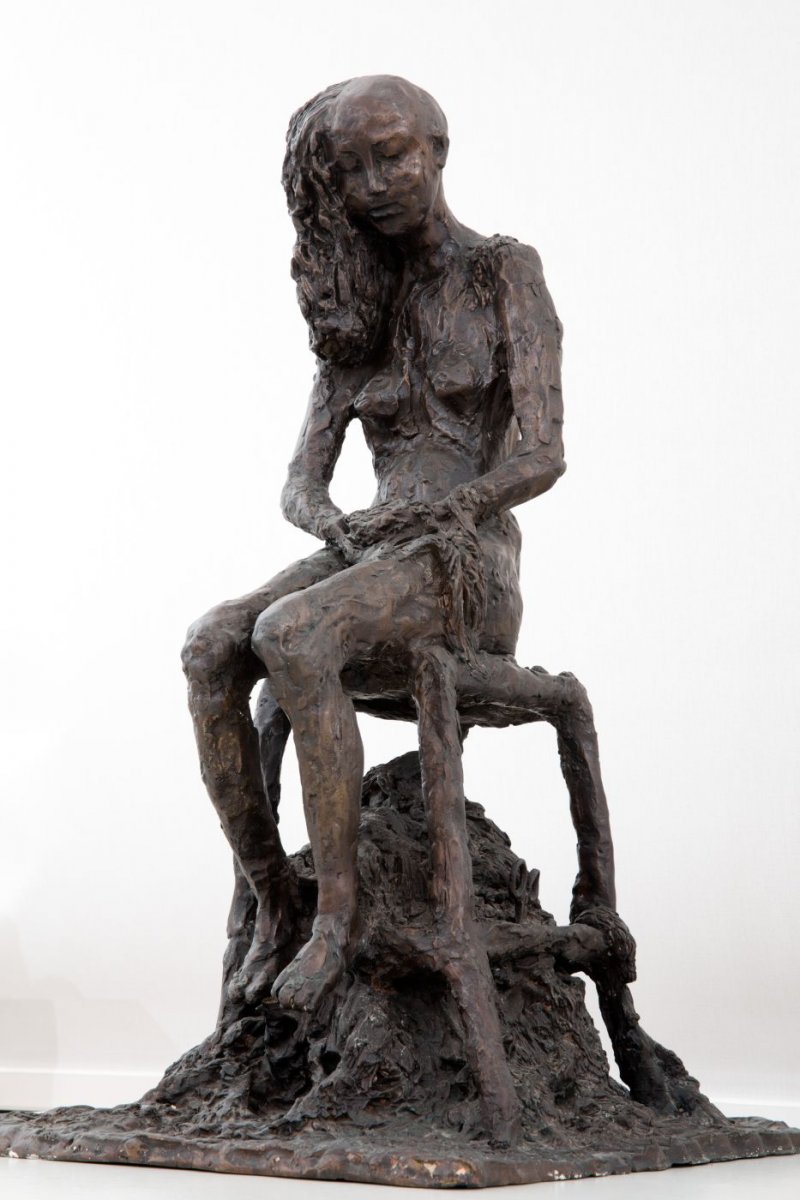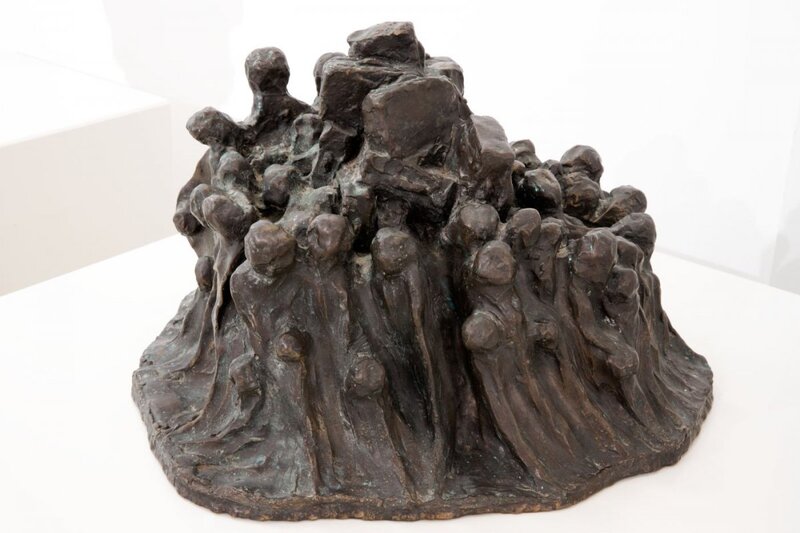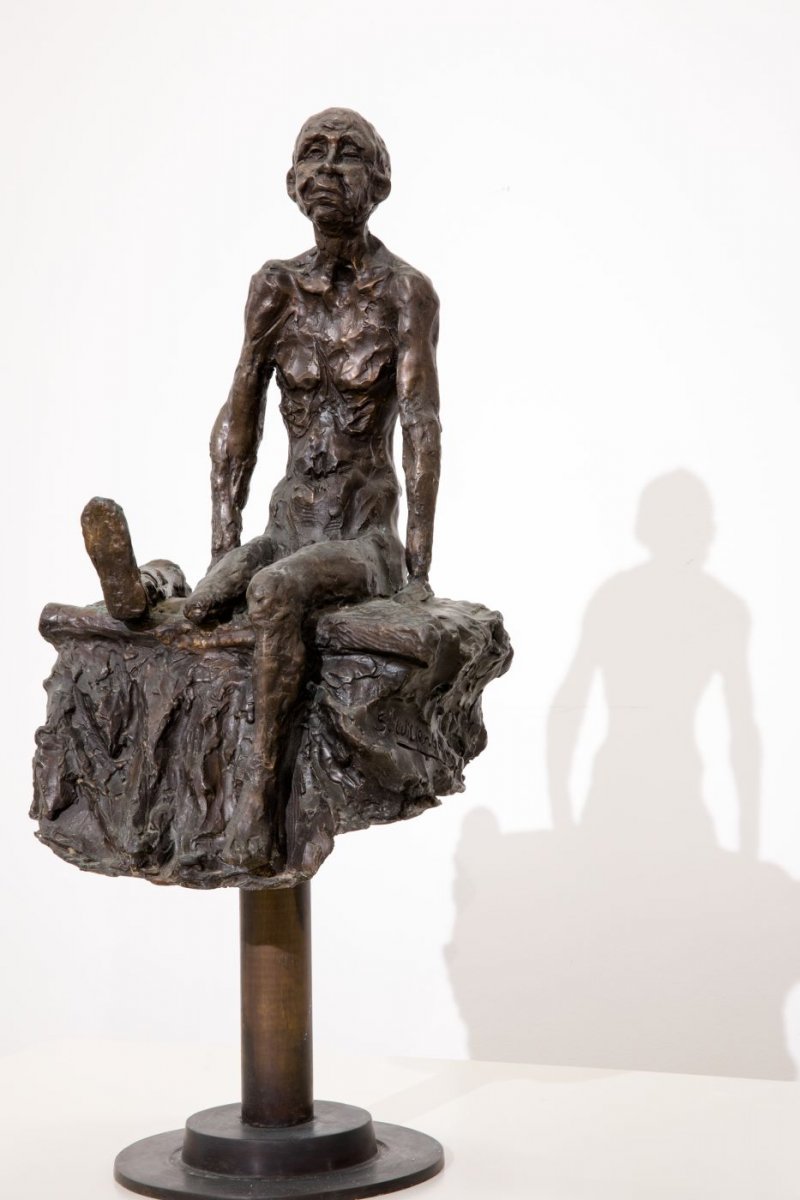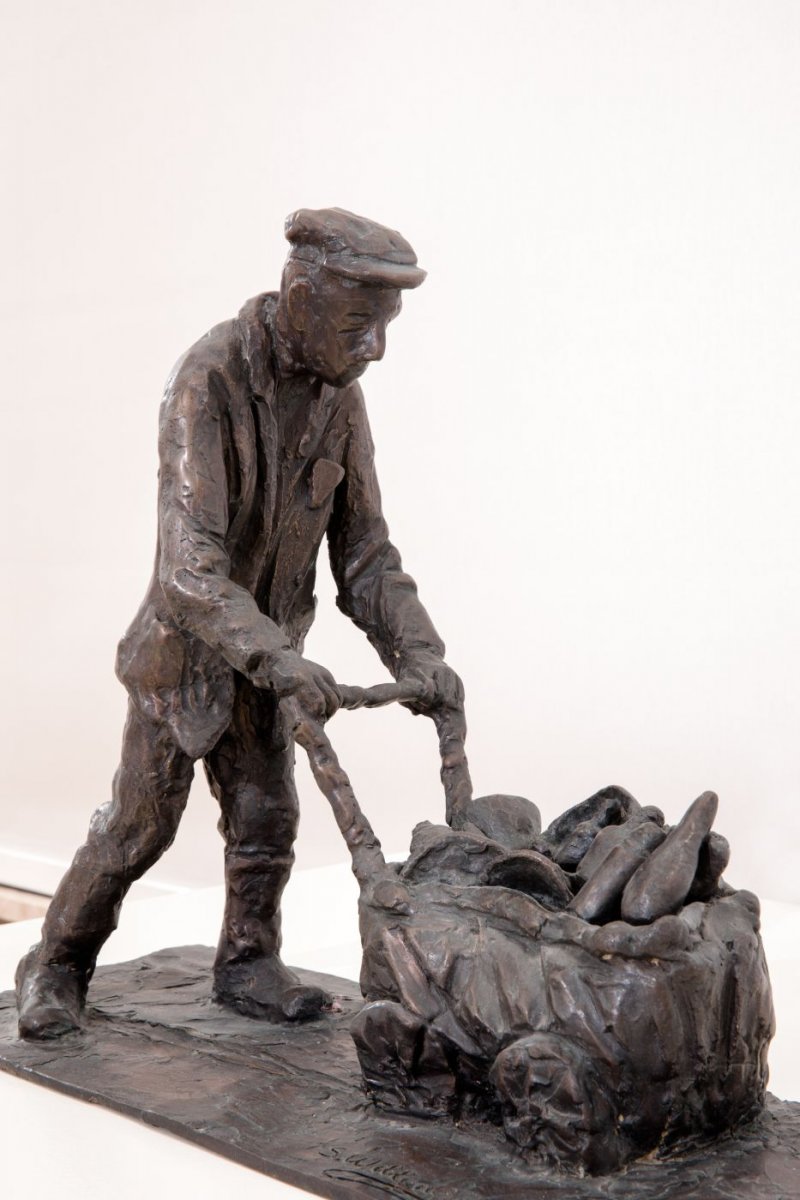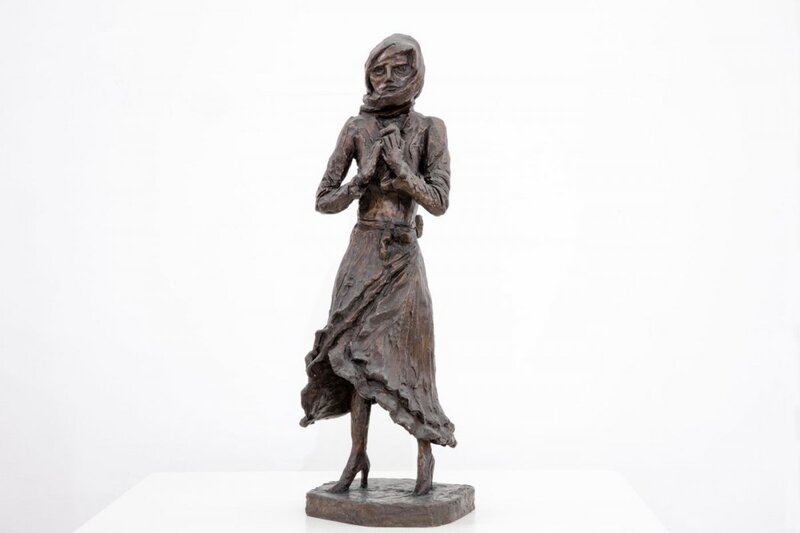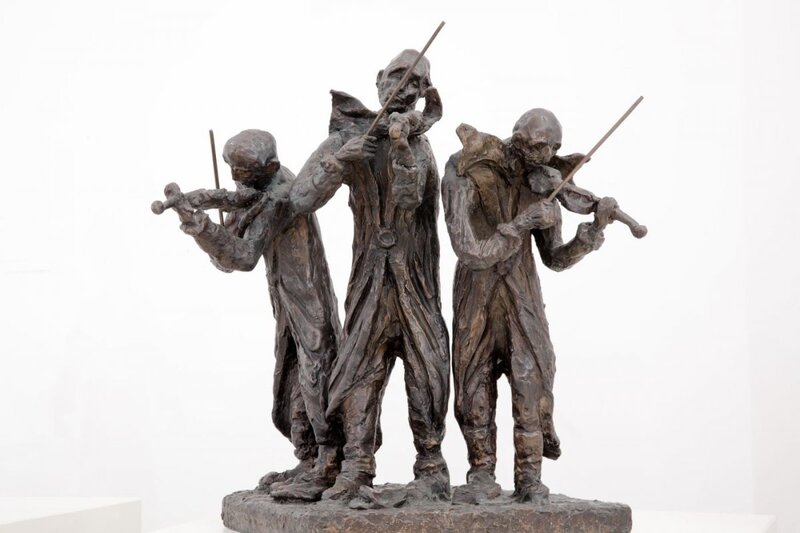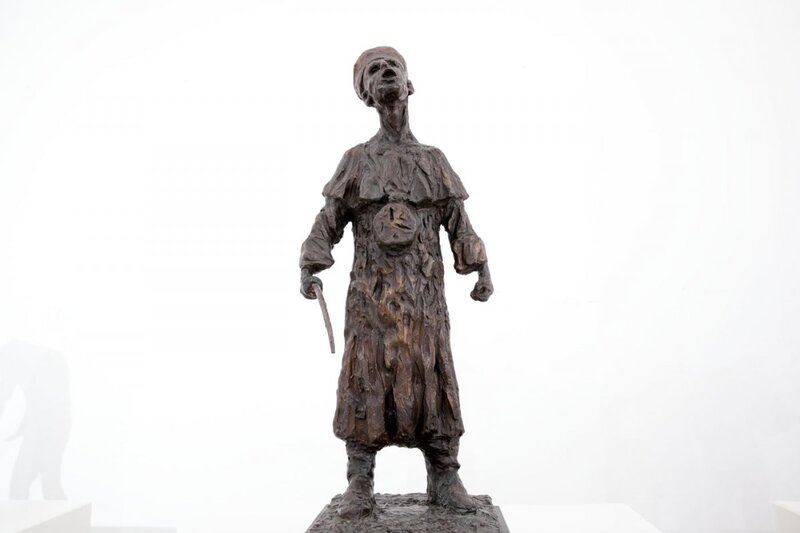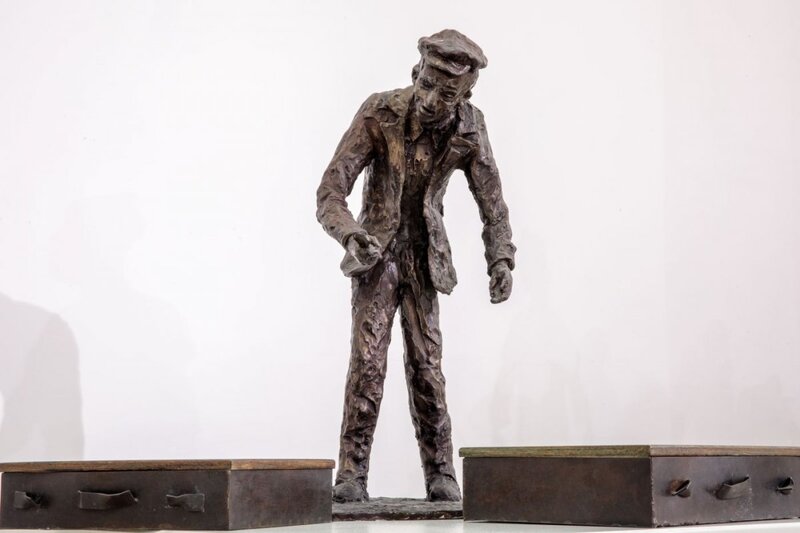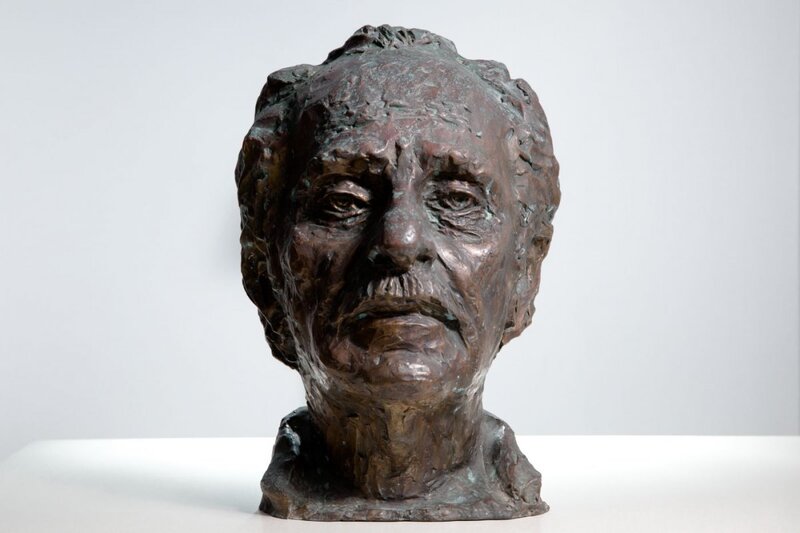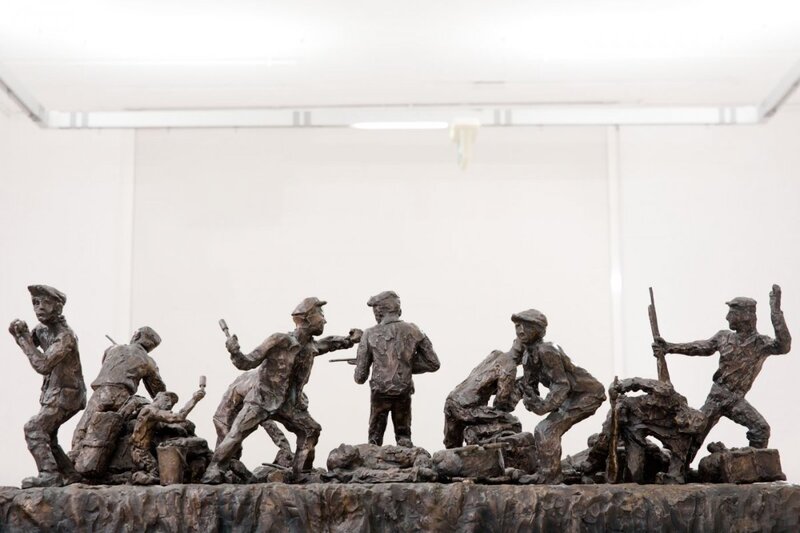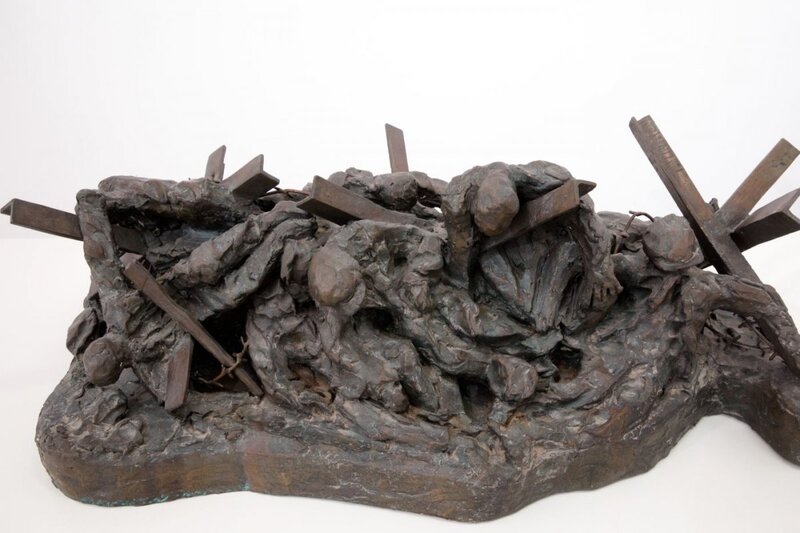Despite the traumatic war experiences in German-occupied Poland, until the end of his life in 2016 Samuel Willenberg had the courage to return to his native country. Since leaving for Israel in 1950, he and his wife Krystyna have on numerous occasions traveled to Poland – either alone or as guides of Israeli youth. They became the spokespeople for good Polish-Jewish relations, openly talking about both the tragic and the beautiful events connecting these two groups of Polish citizens who had experienced the atrocities of German occupation. The Willenbergs are credible witnesses to the tragic fate of Polish citizens, especially of Jewish descent, during World War II.
The Institute’s project aims to commemorate Holocaust victims. The opening of the exhibition of Samuel Willenberg fifteen sculptures depicting everyday life in what can be described as hell on earth, has been prepared by the Institute as part of the celebrations of the International Holocaust Remembrance Day. The event took place one day after the celebrations of the 75th anniversary of the liberation of the German extermination camp Auschwitz-Birkenau, the place symbolizing this tragic crime committed by the German Third Reich.
The sculptures will remain under the care of the Institute of National Remembrance for a year. From 29 January 2020, they will be available to the public at the Institute’s "History Point" Educational Centre on Marszałkowska Str. in Warsaw. The exhibition will further visit Białystok, Częstochowa, Gdańsk, Kielce, Kraków, Lublin and Szczecin. The sculptures will also be the subject of educational workshops for both teachers and students.
The sculptures :
DESCENDING FROM THE BOXCAR
BRONZE, 2000
”One sun-drenched morning […] That day, as every day, the shouts of the foremen were reverberating across the yard as they spurred us on to work. […] From the railway platform we heard the clatter of flanged wheels inching toward the camp. The first morning transport had arrived, loaded with the condemned, who as yet had no idea of what awaited them here.”
The ”BLUES”
BRONZE, 2001
” […] this detail usually consisted of Hasidic Jews […] One could see by their demeanor that most of them had been Yeshiva students and had dressed until very recently in traditional attire. […] This modest group,with the broom as its emblem, was in charge of cleaning the freight cars and scattering disinfectant. It was they who removed the bodies of the people who died in the freight cars during the transport, and hauled them to the ‘Lazarett’ to be
incinerated.”
Lazarett – German: military hospital; in Treblinka: the deceptive term for
the area with a killing pit in which a fire was kept burning.
ORDERED TO REMOVE THEIR SHOES
BRONZE, 2002
“Again the train stopped. Now it lurched backward. The cars rocked violently. Through the grating I saw that most of the train had been left behind at the station. Our wagon and a few others were being pushed slowly onto a siding. […] Then some huts burst into view, beside the track in the forest. Immediately behind them stood a huge pile of shoes; people milled about, this way and that, in the pile and around it. […] I found myself in a yard about 30 meters wide, with huts on either side.[…] I took [a] position within a herd of men alongside the hut. A group of some fifteen Jews, all with red armbands, ordered us to sit on the ground, take off our shoes and tie them together by the laces.”
HOMAGE TO RUTH DORFMANN
BRONZE, 2001
“We entered the hut and proceeded to a little hut where a row of prisoners in white hairdressers’ smocks stood, each beside a small stool. I donned a smock which was hanging on the wall, pulled a pair of scissors from a crack between two boards, and stood like the other ‘hairdressers’, beside one of the available stools […]. Hundreds of women passes my way that day. Among them was a very lovely one about twenty years old […] Her name was Ruth Dorfmann, she said, and she has already graduated from high school. She was well aware of what awaited her, and kept it no secret from me. Her beautiful eyes displayed
neither fear nor agony of any kind, only pain and boundless sadness.‘How long will I have to suffer?’ she asked. ‘Only a few moments,’ I answered. A heavy stone seemed to roll off her heart; tears welled up in our eyes, Suchomil of the SS passed by. We fell silent until he was gone; I continued cutting her long, silken hair. When I had finished, Ruth stood up from the stool and gave me one long, last look, as if saying goodbye to me and to a cruel, merciless world, and set out slowly in her final walk.”
UNDRESSED WOMEN ON THEIR WAY TO THE GAS CHAMBER
BRONZE, 2000
“People were ushered from the platform towards the wide open gate that led to the transport yard. After crossing it, the SS ordered the men to undress, while the women were directed to the hut.[...] Naked women with children were rushed to the row of hairdressers, and then they were led further - to the path of death, to the gas chambers.”
A CRIPPLED JEW AT THE ENTRANCE TO THE „LAZARETT”
BRONZE, 2002
„Huge piles of clothing were ranged parallel to the hut. At the edge of the yard, 150 metres away, stood the fence with its intertwined pine branches. An opening in this fence was marked by a Red Cross flag. […] I reached a little room camouflaged at every angle. […with] benches along the walls. […] Elderly and crippled men sat on the benches, and a Kapo wearing a white apron and a Red Cross armband stood in the middle of the room. He turned to the older people, and with a great deference, asked them to undress for a medical examination. […] they sat down, withered and shivering with cold. Noticing my presence, the orderly ordered me to leave at once through a door to the right. As I obeyed, however, I found a wall of shrubbery in my way; to circumvent it, I turned left and climbed to the top of a raised bank of sand. Ahead of me, a bored Ukrainian sentry sat on a little chair, clutching a rifle. Before him, down below, was a deep pit. At its bottom were heaps of corpses which
had not yet been consumed by a fire burning under them.”
Lazarett - German: military hospital; in Treblinka: a killing pit, disguised
as an infirmary, where the sick and disabled were executed.
AN INMATE COLLECTING BOTTLES
Bronze, 2000
“The prams were used for collecting bottles, thermos flasks, jars and aluminium containers. The prisoners who handled these items had the right to cross the transport yard to a storeroom reserved for them. It was situated behind the hut where the women undressed; there, behind the hut, bottles of all shapes and sizes were piled. The prisoners in charge of bottles were nicknamed the Flaschensortierungskommando – the Bottle-sorting Detail. […] The new detail was ordered to collect all bottles, including broken and small ones, which had once held medicines. […] They were being collected not for any value they might possess, but as part of the coverup of what was happening in Treblinka. When […] the war was over – by which time we would no longer be here – the presence of so many medicine bottles in this little area could only be incriminating. This was the only reason to gather them up and ship them in a direction unknown to us…”
A GIRL FROM WARSAW
BRONZE, 2002
” One little girl was left alone on the platform. Her age was difficult to ascertain. The torn rags which covered her delicate, slender body had apparently been a dress at one time. On her head was a colorful kerchief; she gnawed at its fringes with her white teeth. Her large, doelike
black eyes flashed about in fright. Her skinny legs were red from the frost, and her feet were sheathed in gleaming shoes with very high heels, in stark contrast with the rest of her miserable attire. […] She was clutching a partly eaten loaf of bread to her chest, as if afraid that someone might steal it from her. […] Like an apparition from another world, she approached the sorters one after another, glancing at the contents of the suitcases as if she were browsing around a market […] [the SS man Miete] approached her and pushed her toward the opening in the green fence with its flapping Red Cross flag. No one said a word. […] Everyone watched the little girl from Warsaw being pushed toward the ‘Lazarett’ [German: military hospital; in the camp it was a killing pit, disguised as an infirmary, where the sick and disabled were executed]. She vanished behind the fence. A few minutes later we heard a shot. Silence, utter silence everywhere.”
A CONCERT
BRONZE, 2002
”…Among the [50] new men was the famous Warsaw musician Artur Gold. […He] and the other two prisoners added up to a violin trio […]The trio of musicians began to play popular pre-war tunes which, reminding of years gone by, left us depressed and sore of heart. The Germans were pleased with themselves: they had succeeded in organizing an orchestra
in the death camp. […] After one of these concerts the Germans reached a conclusion: the
maestros did not look good. […] They ordered our tailors to sew jackets of shiny, loud blue cloth, and to attach giant bow-ties to the collars. Dressed as clowns, they entertained us after roll call day in, day out. However spent we might be after a twelve-hour working day, we had to stand in rank and take in a concert.”
AN INMATE IN CANTOR’S GARB
BRONZE, 1999 – 2000
“When the Germans noticed that the prisoners were going to the latrine too often and spending too much time there, the SS Lalka [Yiddish: doll; the camp’s deputy commandant, Kurt Franz] ordered the foremen to go to the storeroom and procure two rabbinical black suits and a couple of black hats with pompons on them. Two prisoners were equipped with whips. It was their job to make sure no more than five prisoners entered the outhouse at any one time, and that they spent no more than one minute inside. Alarm clocks dangled from their necks on strings. They were called the Scheisskommando”. As for their job, they took a contrary attitude to it; thanks to them, the latrines became points of rendezvous between ourselves and prisoners from different groups. Here we exchanged news and information, with the Scheisskommando hovering protectively outside. Whenever a real guard approached, the
Scheisskommando began to make a racket which indicated that it was time to hurry out.”
AN INMATE SORTING BELONGINGS
BRONZE, 2001-2012
“We marched to a large yard behind our hut which was cluttered from one end to the other with mountains of shoes and scattered heaps of clothing and luggage. These rose to a height of some 10 meters around them were thousands of open suitcases, their locks broken, and their owners’ names smeared on them in oil paint. Prisoners would take up positions amid the open suitcases beside the hut and sort all the belongings of the Jews who had been transported
from all over occupied Europe to this dead earth. The suitcases were filled with spoons, knives, eyeglasses, pocket knives, shaving brushes, fountain pens – all the little items packed by the people who had been brought here.”
AN ARTIST – PAINTER INMATE PREPARING MISLEADING SIGNS
BRONZE, 2001
“Another prisoner approached us, a professional painter from Warsaw, a man of medium height with a hawk’s nose and a very black moustache on his fair-skinned face. He was wearing a wide-brimmed black hat, and a narrow black-bow tie around his neck. […] He often talked to me at great length about his work: “I do paintings, portraits, for the Germans.
They bring me photos of their relatives, wives, mothers and children. […] The SS describe their families to me with emotion and love – the color of their eyes, their hair. I produce family portraits from amateurish,blurred black-and-white photos, […] The artist was especially distraught on this occasion. He has been ordered to paint […] an array of little white signs; “First Class’, “SecondClass’., “Third Class’, “Waiting Room”, “Cashier’… and a model of a large, round wall clock. […] Several days later, the Germans ordered us to hang
[…] the clock on the wall of the hut alongside the platform. Now the platform looked like an ordinary railway station.”
THE HEAD OF THE ARTIST SAMUEL WILLENBERG
BRONZE, 2002
2 AUGUST 1943 – THE INSURRECTION
BRONZE, 2002-2003
”The date chosen was 2 August 1943, a day I shall never forget. […] As that long-anticipated day dawned, our hearts pounded with the hope that now, maybe, our dream would at last come true. We had little thought for ourselves and our lives. Our overwhelming desire was to obliterate the death factory which had been our home. […] Utter silence reigned in the camp. The familiar sentries were positioned on the watchtowers as usual, fixing languid eyes on us. SS men hurried about the area just as they did every day. Nothing at all hinted at what was about to unfold here. The silence was meant to fool our enemy. […] the Germans, ordinarily so suspicious, were off their guard. They did not imagine that a prisoners’insurrection was about to break out that day. The rebellion was timed to start at 4:30 p.m. […] Shortly before 4 and not as planned we heard an explosion from the direction of the Germans’ huts. The Ukrainian at the gate to the vegetable patch let loose a burst of gunfire. One of our men returned fire; the Ukrainian fell lifeless at the fence. I seized the rifle and ran to the Germans’ compound. I could see rifles protruding from the windows of the Ukrainians’ huts, firing into the forest. […] As the hail of gunfire intensified, other prisoners followed us toward the gate.
We heard thunderous explosions from the garage; flames soared over the trees. A pillar of fire burst from the garage; the Germans’ huts burned […] The dry pine branches we had woven into the fence burned as well […] Treblinka had become one massive blaze.”
2 AUGUST 1943 – ESCAPE DURING THE INSURRECTION
BRONZE, 2002
” I ran with the others toward the vegetable garden. Reaching the fence, I was greeted by a horrifying sight: masses of human corpses strewn between the tank obstacles. Dead prisoners stood erect like tombstones; dozens of human bodies leaned against the obstacles and the barbed- wire fences. Machine-gun fire continued to rain down relentlessly from the watchtowers. As I skipped across the bodies of my dead comrades, I felt a sudden pain in my leg and a sharp blow. My shoe filled with blood. I had been hit in the leg. Limping, I reached the railway track. […] I was alone, desperately thirsty, and dressed only in a shirt and trousers. One of my shoes was filled with blood; my leg throbbed horribly. I removed the cap from my shaven head. […] I had no clear plan of action; I depended only on my instincts.”
The source of the quotations : Samuel Willenberg “Surviving Treblinka”,
Basil Blackwell Ltd, Oxford 1989
Samuel Willenberg
16.02.1923 - 19.02.2016
Samuel Willenberg was among 200 inmates who on 2 August 1943 succeeded in escaping from the Treblinka German extermination camp. At the moment of his death in 2016 he remained the last survivor of the rebellion in Treblinka.Samuel Willenberg was born in 1923 in Częstochowa, Poland, the son of Maniefa, nee Popov, and Perec Willenberg; he had two sisters, his elder Itta and younger Tamara. In October 1942 he arrived at the Treblinka camp in a transport of 6,000 Jews deported from the Opatów ghetto. Most perished immediately; he was the only one who remained alive.
On his first night in the camp, Willenberg heard “a familiar voice, as if from a great distance”; it was Professor Merring, his elementary school history teacher. That night Merring urged him, “You’ve got to escape from here and tell the world what you’ve seen. That will be your duty.” Willenberg was in Treblinka until the outbreak of the rebellion on 2 August 1943. He saw with his own eyes the arrival of hundreds of thousands of Jews and thousands of Roma and witnessed them being sent to death in the gas chambers; his own sisters Itta and Tamara were killed there. Willenberg himself suffered humiliation, violence, cruelty and extreme viciousness at the hands of the German SS staff and the Ukrainian “SSWachmänner” guards.
Inmates in the camp organized the rebellion with the objective of avenging the murders and destroying the extermination facilities. Willenberg took part in the uprising and was shot in the leg. Wounded and under gunfire,he managed to escape and reached Warsaw.Under the assumed name of Ignacy Popov (“Igo”), he took part in the Warsaw Uprising of August 1944, first within the ranks of the Home Army (AK) and then the Polish People’s Army (PAL).
After the war he remained in Poland. In 1950, following his father’s death,he emigrated to Israel with his mother and his wife, Ada.
Professor Merring was killed in Treblinka and Samuel Willenberg carried out his teacher’s behest until his death. Willenberg wrote his memoir of the camp and uprising and commemorated them in his book SurvivingTreblinka (1984). He made pencil drawings and cast bronze sculptures based on his memories of the murder site. He and his wife accompanied youth delegations and tours to Poland, to give testimony about what he had experienced in Treblinka. For his activities during and after the SecondWorld War Samuel Willenberg received the highest national honours of the Republic of Poland, including the Virtuti Militari, the Crossof Merit with Swords, the Cross of Valour, the Warsaw Uprising Cross, the Order of Merit of the Republic of Poland, the Order of Polonia Restituta, and the Polish Army Medal.
This exhibition presents sculptures, drawings, and excerpts of his testimony,describing figures and scenes that Willenberg remembered and wanted to commemorate. In spite of the perpetrators’ efforts to destroy all traces, the sculptures provide direct evidence of their deeds.
